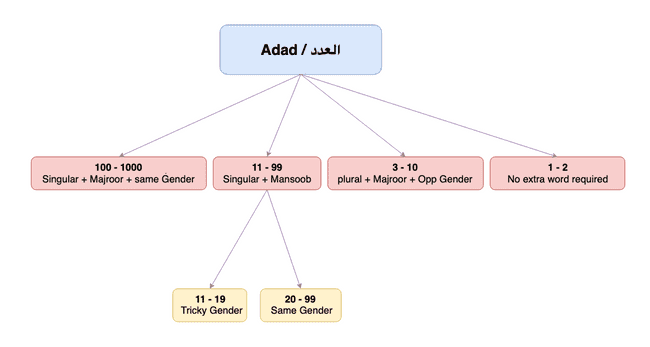Adad
Published: 2019-01-12 • Updated: 2019-03-02Adad or العدد is a very fascinating concept of Arabic grammar in which we learn how Arabs used to count things.
Disclaimer Arabic counting gets very tricky. So have patience and do a lot of Istigfaar in the meantime :)
Lets divide the numbers into 4 cases and begin with
Case 1 العدد of 1 and 2
| المفرد | اشتريت كتاباً |
|---|---|
| المثنى | اشترت كتابين |
Where كتاباً itself means a single book and كتابين means two books. So we don't need any extra word to describe its count.
Case 2 العدد from 3 to 10
Rule It is plural and Majroor (i.e. تمييزه جمع مجرور) with opposite Gender (i.e. العدد يخالف المعدود)
Example:
- اشتريت ثلاثة كتبٍ
كتبٍ مضاف إليه مجرور وعلامة جره الكسرة
OR
تمييز مجرور وعلامة جره الكسرة
where ثلاثة is عدد and كتب is معدود
Also اشتريت ثلاثة كتب and اشتريت ثلاثة من الكتبِ means same thing. We can use both formats.
More examples:
- رأيت ثلاثةَ رجال
- رأيت ثلاثَ نساء
- رأيت عشرة رجال
- رأيت عشر نساء
Case 3 العدد from 11 to 99
Rule It is Singular and Mansoob (i.e. تمييزه مفرد منصوب)
Example: اشتريت أحد عشر قلماً
قلماً تمييز منصوب وعلامة نصبه الفتحة
Case 3a Gender from 11 to 19 is يوافق المعدود
- جاء ثلاثةَ عشرَ رجلاً
- Gender of عشرَ is same as رجلاً and ثلاثةَ is opposite of رجلاً
- رأيت ثلاث عشرة امرأة
- رأيت أحد عشر رجلاً
Case 3b Gender from 20 to 99 doesn't change (لا تتغير)
- رأيت ثلاثاً وعشرين امرأةً
- رأيت ثلاثةَ وعشرين رجلاً
Case 4 العدد from 100 to 1000
Rule It is Singular and Majroor (i.e. تمييزه مفرد مجرور) and doesn't change (لا تتغير)
Example: اشتريت مائة كتابٍ
كتبٍ مضاف إليه مجرور وعلامة جره الكسرة
OR
تمييز مجرور وعلامة جره الكسرة

Points to Remember
- Look at singular المعدود whether it is masculine or feminine not its plural form i.e. (ننظر إلى مفرد المعدود هل هو مذكر أو مؤنث ولا ننظر إلى الجمع)
- Example in سخرها عليهم سبع ليال وثمانية أيام حسوماً we will consider ليلة (feminine) and يوم (masculine) NOT ليال (masculine) and أيام (feminine)
- 1985
- 5 = آحاد
- 8 = عشرات
- 9 = مئات
- 1 = آلاف
- 1440
- Right to Left: سنة ألف و أربعمائة وأربعين
- Left to Right: سنة أربعين وأربعمائة و ألف
العدد المركب
It is from 11 to 19 (أحد عشر - تسع عشر)
Both the parts are Mabni (مبني على فتح الجزئين) i.e. أحد and عشر both mabni.
For Example:
- جاء أحدَ عشرَ رجلاً
- أحدَ عشرَ is Fai'l
- رأيت أحدَ عشرَ رجلاً
- أحدَ عشرَ is Mafool Bihi
- ذهبت إلى أحدَ عشرَ رجلاً
Irab of جاء أحدَ عشرَ رجلاً
أحدَ عشرَ عدد مبني على فتح الجزئين في محل رفع فاعل
Exception with 12 i.e. اثنا عشر where اثنا is Mo'rab and عشر is Mabni (الجزء الأول معرب والجزء الثاني مبني على الفتح)
- جاء اثنا عشرَ رجلاً
- رأيت اثني عشرَ رجلاً
- ذهبت إلى اثني عشرَ رجلاً
Irab of جاء اثنا عشرَ رجلاً
اثنا عشر اثنا فاعل مرفوع وعلامة رفعه الألف نيابة عن الضمة عشر مبني على الفتح
That's it folks !!!
That's how Adad in Arabic works
